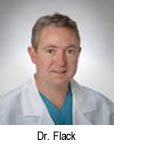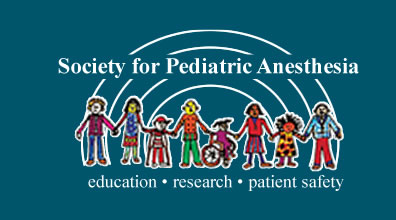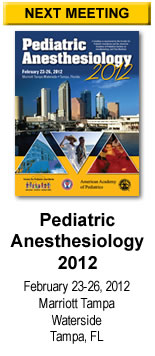SPA Annual Meeting Reviews
For a gallery of photos from the Annual Meeting, click here.
The 25th Annual Meeting of the Society for Pediatric Anesthesia was held on October 14th, 2011 in Chicago. Welcoming remarks were provided by SPA President Dr. Lynn Martin and Program Chair Dr. Wendy Binstock. The Society was celebrating its 25th anniversary and the theme was a look at the past, present and future of the practice of pediatric anesthesia.
The first session started with Introduction to the Pioneers in Pediatric Anesthesia. Dr. Christine Mai (Mass General) provided a discussion of the early pediatric anesthesia pioneers including Dr. Robert Smith who is considered the Father of Pediatric Anesthesia. Dr. Mai’s presentation provided a history of the field of pediatric anesthesia as well as the history of the Society for Pediatric Anesthesia.
Dr. Myron Yaster was given credit for the formation of a society that was for pediatric anesthesia by getting together the masters of the field for a meeting in 1985. Within two years, the first meeting of the SPA occurred in 1987. Ten years later, the “Gang of 7” put in application for ACGME Pediatric Anesthesia Fellowship that was accredited February, 1997. Dr. Mai then showed a video of the true early pioneers and the practice that went back as far as ether and chloroform anesthesia.
Interviews with some of the pioneers provided the audience with a glimpse into some of the early stories. These stories were told by anesthesiologists such as Drs. Charlie Coté (Mass General), Nishan Goudsouzian (Mass General), Jack Downes (CHOP), and Mark Rogers (Johns Hopkins).
 Pediatric Transplantation – Where have we been, and where are we going?
Pediatric Transplantation – Where have we been, and where are we going?
By Dr. Allison Ross
Duke University
The first topic of the conference was moderated by Dr. Anne Lynn (Seattle Children’s Hospital).
Dr. Linda Jo Mason (Loma Linda) started with Pediatric Cardiac Transplantation-From Vision to Reality. She discussed the first human to human heart transplantation in Capetown, South Africa in 1967 that was featured in Life magazine. Despite only living 18 days, it was considered a success.
Three days after the adult transplant, the procedure was performed on an infant by Dr. Kantrowitz. The history of heart transplantation in children at Loma Linda in the 70’s included issues with immune suppression and how to secure donors. The transplantation of a baboon heart to Baby Fae raised awareness that donors were needed.
8,533 pediatric heart transplants have occurred in the world with about 450/year in approximately 80 centers. 25% of these transplanted patients were in children less than a year of age with North America being the primary location. The leading cause of death in these children has been graph failure. In addition, there has been evidence of poor developmental outcome with 40% of patients having cognitive issues that require special education.
Concerns after transplantation that pediatric anesthesia providers need to be aware of include late graft rejection, left graft failure with left ventricular dysfunction, and coronary artery disease. The incidence of coronary vasculopathy is very low when children are not having graft rejection. Medications such as Sirolimus/Everolimus are used, and when Sirolimus is added, there is decreased graft loss. Intravascular ultrasound is used to screen for vasculopathy and it is performed every other year as a part of the catheterization.
The bottom line is that the way to reduce chronic rejection is to prevent it. Unfortunately, post-transplant lymphoproliferative disease results in a 40% mortality. The future of heart transplantation includes earlier diagnosis of graft rejection, tolerance induction/recognition, mechanical device to bridge, and enhanced surveillance. ABO-incompatible donors are also a newer alternative. In conclusion, Dr. Mason stated that heart transplantation has come a long way and she finished with a video that showed a host of transplant survivors and the message that it takes a team.
Dr. Stuart Hall (Texas Children’s) then spoke on Pediatric Pulmonary Transplantation: An inspiration? Dr. Hall started with what makes lung transplant different by pointing out that lungs have a huge surface area that is exposed to pathogens, the nutrient arterial supply is not routinely included in anastomosis, and bronchiolitis obliterans remains a huge obstacle.
The history of lung transplantation goes back to 1963, when a prisoner in Mississippi received the first lung transplant. The ischemic time of the procedure was 90 minutes and the prisoner/patient lived for 18 days before succumbing to renal failure. There was no evidence of rejection at time of autopsy despite ABO incompatibility.
The first pediatric lung transplant was performed in a 16 year-old with pulmonary fibrosis in Toronto in 1987. Since then, lung transplantation in children has grown in volume considerably, but not near the adult volumes. From the period of 2001-2011, 60-90 lung transplants/year in children occur whereas there are 1000-2000 transplants/year in adults. Most pediatric transplants are in ages 11-17 years, 53-69% have cystic fibrosis, and the half-life of a pulmonary graft is about 5 years.
Contraindictions to lung transplantation include severe tracheomalacia, h/o pleurodesis, laryngeal incompetence, and possibly scoliosis. There are also medical contraindications such as active viral infection, pre-transplant ventilation (except in neonates) and psychosocial issues. Operative considerations include the fact that there is a need for cardiopulmonary bypass, it is difficult to do lung isolation, living donors are not feasible, and it is hugely resource-intensive. The procedure involves a clam shell incision.
Upon completion of the transplant, management includes bronchoscopy by the anesthesiologist to examine anastomoses and clear airways, keep FiO2 less than 0.6, place nitric oxide to 20 ppm, and do not give large recruitment breaths. Epidurals are considered to be helpful with postop pain, but not those with sternontomy, less than 3 years, preop vent or tracheostomy. Although epidurals are thought to help facilitate earlier extubation, no significant differences between VAS, LOS, time to extubation or ICU stay has been shown compared to patients without epidurals. However, the trend suggests that epidurals are advantageous and this would be shown if sample size was higher.
To finish the discussions on transplantation, Dr. Peter Davis (Pittsburgh Children’s) presented the Then and Now on Liver Transplantation. After a brief opportunity to discuss the benefits of living in Pittsburgh, including the winning of six Super Bowls, he moved on to the matter at hand of liver transplantation.
The number of patients waiting for livers has not changed dramatically and there are fewer patients who are dying on the waiting list with the exception of those patients less than 1 year of age. The kids who are typically transplanted are those with biliary atresia and other metabolic diseases, but retransplants have decreased from 36% to less than 12%.
Surgical technique has improved over the years from the challenging case with issues at clamping that often required significant intervention, to more of a piggyback technique, living related liver transplants, split grafts, reduced grafts and hepatocyte transplant. Anesthetic concerns are likewise improved with 14% of pediatric patients receiving no blood at transplantation, and 42% receiving less than half of a blood volume in the last 50 transplants in Pittsburgh.
The average transplant in the not too distant past was actually 3-4 blood volumes/transplant. Kids less than a year of age still present a higher ml/kg of packed red blood cells transfused, and none of them have gone without a transfusion. Other changes include immunosuppression which is considered the wave of the future. Steroids are no longer used, Tacrolimus has replaced cyclosporine, and Thymoglobulin induction is common. These changes have resulted in a 76% one-year survival compared to a previous 40% one-year survival with some centers having survival data at one-year close to 90%.
Postoperative complications may be serious with the major ones being hepatic artery or portal vein thrombosis. The abdomen is often left open and this improves outcome. Infection is always a concern. HAT was a leading killer of kids after transplant with an incidence of 25% in 1987 which is now about 6%. Disease and technique are what predict graft survival. 88% of organs are coming from deceased donors whereas living are 12%. LRLT is higher in Pittsburgh, but the outcomes are better. Survival after retransplantation is markedly different than a primary transplant. LRLT have a much lower retransplant rate.
Survivors do have changes in their quality of life. Renal dysfunction occurs in 32%, 50% suffer from hypertension, and there are also risks of cancer and issues of compliance in adolescents. Although the outcome of 5-year survivors may mean good graft function, chronic medical conditions involving many organ systems often occurs in addition to psychosocial issues that result in 18% of the children needing to repeat a grade of school. Dr. Davis strongly recommended that there be more work done in taking care of the donors as it is truly an ischemia-reperfusion-harvest model that has not been studied.
 The Future is Here
The Future is Here
By Dr. Sean Flack
Seattle Children’s Hospital
The second session titled “The Future is Here” was moderated by Jerrold Lerman MD (University of Rochester, Buffalo NY). Mark J. Bloom, MD, PhD (New York University, New York NY) and Mohamed A. Rehman, MD (The Children's Hospital of Philadelphia, Philadelphia PA) delivered a pro-con debate Then and Now: The State of Medical Electronic Records. Dr Bloom observed that paper records are cheap, easy to use, portable and lightweight. They are highly reliable (no “down-time”) and allow for accurate non-contemporaneous charting. Monitoring artifacts are easily excluded from the record which is also simple to annotate.
The slow market penetration of electronic records was noted: 27% of 5,000 United States hospitals are under contract to implement electronic records and only 14.8% are currently live or actively implementing their electronic record. Deterrents to wider adoption are thought to include cost, legal implications and the behavioral changes required to successfully migrate from paper to electronic.
In response, Dr Rehman highlighted the advantages of electronic anesthesia information management systems (AIMS). These include more accurate data collection, increased completeness and legibility, decreased anesthesia workload and immediate availability from multiple locations, including at home. Automated reminders can be created to improve documentation, such as allergy field completion, and clinical practice, such as on-time delivery of antibiotics (Curr Opin Anaesthesiol 2009; 22:215-222).
Additional references for those interested in AIMs include: Solovy A et al. The 2007 Most Wired results. Ten lessons from the top 100. Hosp Health Netw 2007; 81:40-55 and Adler R. Health Care Unplugged: the Evolving Role of Wireless Technology. Oakland: California HealthCare Foundation; November 2007.
Steven L. Shafer MD (Stanford University, Palo Alto CA) was scheduled to address the question Where will Pharmacogenetics Take Us? In his lecture summary, Dr Shafer observes that there is a revolution in the field of pharmacogenetics. The number-crunching abilities of computers allow for rapid identification of genes responsible for important biologic phenomena. This field of study is made possible by the development of numerous strains of mice that are homozygous at all loci. Each strain has a different arrangement of single nucleotide polymorphisms (SNPs) across their genomes. The SNPs of various mice strains with or without a certain phenotype can now be analyzed and differences identified. This is where in silico pharmacogenomics comes into play. This ultra high resolution mapping of SNPs, combined with complex computational and statistical methodology, allows investigators to identify the region of DNA responsible for particular phenotypic expressions. As Dr. Shafer observes, this is indeed, the ability to “find the needle in the haystack."
Recent successes include genetic impacts on chronic pain states. For example, Liang et al (Anesthesiol 2006; 104:1054-62) observed a relationship between the beta adrenergic receptor and opioid-induced hyperalgesia. The finding by Smith et al (Pharmacogenet Genomics 2008; 18:231-41) that an inward rectifying potassium channel modulates analgesic response to multiple drugs may lead to the identification of novel targets for analgesic action. In his summary, Dr Shafer highlights the recent finding in mice that the 5-HT3 receptor plays a role in modulating opioid dependance and that ondansetron helps control signs of opioid withdrawal in human volunteers (Chu et al. Pharmacogenetics and Genomics. 2009; 19:193-205).
Dr. Shafer concludes that we are the beginning of this genetic revolution. This powerful research tool is identifying novel therapeutic targets and answering longstanding questions related to mechanisms of action for analgesics and anesthetics. The development of novel analgesics is likely.
Complete DNA sequencing at minimal cost is just a few years away. Once that happens, we will be presented with patients that have been completely sequenced. We will know each patient’s risk for drug side effects and how best to tailor our anesthetic and analgesic plan. Anesthetic risk disclosure and anesthetic choice will be truly individualized and patient-specific.
Following the morning sessions, lunch featured Round Table Discussions with a host of pioneers, experts and their colleagues. There were multiple topics from which to choose and it allowed for thought-provoking discussions between providers who were at all levels of experience.
Anesthesia for the Neonate: Yesterday, Today and Tomorrow
By Dr. Henna Tirmizi
CA-2 Resident, University of Maryland Medical Center
The intricacies of neonatal physiology and the unique effect of various anesthetic agents on the neonate are truly appreciated by the pediatric anesthesiologist. At the 25th annual Society of Pediatric Anesthesia meeting, attendees were indulged with a panel including Dr. George Gregory, Dr. Myron Yaster, Dr. Sol Soriano, and Dr. Mervyn Maze. The audience traveled through time as the history of neonatal anesthetics, current issues, as well as future developments were discussed by the panelists.
Dr. George Gregory (UCSF) began with a discussion with past uses of diethyl-ether, pancuronium and oxygen. He explained how ether was a useful anesthetic for the time it first began to be used. It had a wide margin of safety. Lightheartedly, he explained that other than the side effect of tending to explode easily, it was a good anesthetic.
Moving on to his discussion of pancuronium, he stated that although it has the good effect for neonates of increasing the heart rate, it had dropped out of favor due to increased chance of delayed awakening and paralysis present without sedation or anesthesia. His final topic was the use of oxygen in the neonate. First given in 100% concentration into neonatal incubators, it would cause retinopathy of prematurity. However, if not given when needed, it would lead to cerebral palsy or death. The well known facts of today were learned through adverse outcomes at first.
Dr. Myron Yaster (Johns Hopkins) moved the discussion into the present by speaking about opioids in neonates. He started the transition by discussing studies that brought forward our current understanding of neonatal pain. He stated that from the 1960s-1980s neonatal anesthesia was more of a resuscitation than an anesthetic. It was believed that the newborn could not experience pain, and premature infants were “too sick” to undergo anesthesia.
Dr. Yaster emphasized that studies have shown that a newborn, no matter how sick, needs anesthesia, and failure to provide it can result in serious consequences in the neonate’s future. He spoke of the dose response to fentanyl in neonatal anesthesia, as well as multicenter trials with remifentanil and resulting hemodynamic stability and rapid extubation. Dr. Yaster also commented on the pioneers of regional anesthesia in the neonate, and how its widespread acceptance began once it was paired as a component of general anesthesia.
The popularization of the caudal catheter to provide a thoracic epidural, the use of spinal anesthesia, as well as ultrasound techniques to place ilioinguinal and iliohypogastric nerve blocks were game changing in the world of neonatal anesthesia.
Next, Dr. Sol Soriano (Children’s Hospital Boston) spoke about inhalational anesthetics and neurotoxicity in neonates. He explained how studies have shown that volatile anesthetics have led to accelerated neuroapoptosis. He showed that there can be a link between established neurotoxins such as fetal exposure to alcohol and anesthetic agents.
Children exposed to anesthesia at an early age are at an increased likelihood to express maladaptive behavior, have learning disabilities and were more likely to be in special education. Emphasis is placed on continuing research in the area, defining periods of increased vulnerability and providing anesthesia for neonates in the safest means possible.
Dr. Soriano spoke about Smart Tots, an organization funding research to ensure pediatric safety. Supporting such organizations financially, as well as participating in research through them, will help answer such questions. Dr. Soriano highlighted how we should continue to practice clinical anesthesia and strive towards good outcomes.
Dr. Mervyn Maze (UCSF) rounded out the afternoon discussion by looking into the future of neonatal anesthesia. He explained that under the anesthetized state with agents such as propofol and ketamine, cell survival pathways are affected and death receptors are activated. Dr. Maze stated that agents such as Lithium reduce ketamine induced apoptosis.
Also, while nitrous oxide exaggerates isoflurane induced neuroapoptosis, Xenon, an NMDA antagonist, actually decreases it. Dr. Maze continued with a discussion of prolonged ICU sedation. In neonates, it promotes tolerance, dependence, and poor sleep hygiene. While benzodiazepines do not lead to REM type sleep, newer agents such as dexmedetomidine produce sleep that is more similar to natural sleep as well as have a decreased incidence of delirium.
He concluded his discussion by stating that more research with non-human primates needs to be conducted. Dexmedetomidine and Xenon do not have pediatric labels and have their own drawbacks. It is important to increase our knowledge in these areas, since not all agents have a propensity towards cognitive dysfunction. In this manner, we will be able to provide neonatal anesthesia in the safest manner possible.
 Monitoring in Pediatric Anesthesia – Then and Now
Monitoring in Pediatric Anesthesia – Then and Now
By Dr. Zulfiqar Ahmed
Children’s Hospital of Michigan, Detroit
Moderating this session on monitoring was Dr. Nina A. Guzzetta (Emory University).
The first speaker was Dr. Randall Wetzel (LA children's Hospital) who provided a stylish discussion on the evolution and development of pulse oximetery. He started with the notion that during the early stages of anesthesia practice, the initial assessment of the patient's clinical status was primarily dependent on personal observation. Pulse oximetry began to appear in the operating room in 1990s. The basis of pulse oximetery was formed with refinement of technology and developments in optics along with the description of Beer-Lambert Law.
An important milestone was achieved when Glenn Milliken, an American physiologist, was asked to devise a breathing apparatus for pilots of Royal Air Force, who would lose consciousness at high altitudes due to low oxygen levels. As part of the project, he devised an oximeter which was incorporated in the pilot's suit and measured the blood oxygen saturation at high altitudes. The oximeter was applied on the pilot's earlobe and measured blood oxygen saturation in a nonpulsatile fashion. Later Takuo Aoyagi devised the pulse oximeter to measure the pulsatile flow of blood in tissues to measure blood oxygen saturation. This achievement led the pulse oximeter to become widely available and an easy to use tool in everyday clinical practice.
Dr. Wetzel’s quote from a famous 1978 song by Sweet, “Love is like oxygen”, drew a huge laugh from the audience.
“Love is like oxygen
You get too much, you get too high,
Not enough and you’re gonna die.”
The second speaker of the session was Dr. George Hoffman (Children's Hospital of Wisconsin). His topic was NIRS and Venous-Side Monitoring of the Circulation. Dr.Hoffman presented an elegant review of cardiovascular physiology as it relates to monitoring venous oxygen. Dr. Hoffman discussed the regional oxygen delivery and its relation to cardiac output and regional organ vascular resistance. He described that regional oxygen saturation is a good index of flow-metabolism relationship. His message was to monitor oxygen delivery in specific organs such as kidneys. NIRS as an example of noninvasive infrared monitor can be used to trend regional perfusion. This method correlates well with the tissue venous hemoglobin saturation as a measure of regional blood flow.
To bring the meeting full circle, Dr. Christine Mai finished up by moderating a session that allowed a Panel of Pioneers to present My Favorite Story. This concluded the 25th Annual Meeting of the Society for Pediatric Anesthesia. However, the evening was the grand finale where a wonderful time was had by all at the Chicago Yacht Club and included live entertainment by the band, The Voltage Brothers. It was a fitting finish to a terrific anniversary program.


